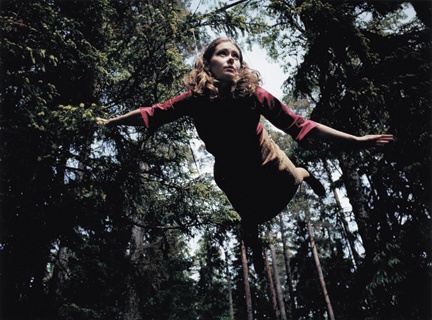Sounding the Subject at MIT's List Visual Arts Center
Video Art from the Kramlich Collection and New Art Trust
By: Shawn Hill - Dec 20, 2007
Sounding the Subject and Video Trajectories:
Selections from the Pamela and Richard Kramlich Collection and the New Art Trust
Hayden and Reference and Bakalar Galleries
List Visual Arts Center/ MIT
Cambridge, MA
through December 30, 2007
http://web.mit.edu/lvac
Video art occupies an odd and unique place in the world of contemporary art. As relatively new media, the means of archiving, displaying and even selling it are still up in the air. Issues of originality and authenticity are magnified from the usual concerns over artist's editions when digital and transmittable media enter the arena. Issues of collection and ownership can be complicated legal tangles.
Conversely, video artists share some of the financial benefits of photographers, those lucky artists who have a readily marketable product for which there is an established need and relatively viable pay structure. The technology is understood (and usually borrowed from commercial media rather than invented for fine art use alone) and there's a ready audience for filmed work. In fact, sometimes the hardest aspect of video art is audience access, despite demand. Without a commercial distribution system (as profit is not the goal), video art is often handled by museums, non-profit galleries, the artists themselves, and various trusts that try to figure out the optimal distribution system and reasonable fee structures while protecting intellectual property rights.
The MIT List Visual Arts Center (LVAC) has considered all these issues in their current showcase of avant-garde and seminal video work, and they've made some controversial decisions to achieve maximum display saturation. In the Hayden Gallery, there are five works, total, each given room to breathe (and, most importantly, room to sound and be heard). In the Bakalar Gallery, a much larger body of video works are available at minimal, elegant viewing stations, each with a chair, desk, set of headphones and portable DVD player.
In the latter the works are, for the most part, not at all in their original configuration or intended viewing environment. They've become tracks on a greatest hits disc.
They are viewable in a way that many of us choose to process video imagery. On display are important works by Vito Acconci, John Baldessari, Gary Hill, Joan Jonas, Mariko Mori, Bruce Nauman, Richard Serra and Bill Viola (among others) that any serious video connoisseur should know. I imagine the curators could have purchased twenty video iPods, too, and given us even smaller and more intimate screens, without the need for dedicated stations and a power plug. Instead they've opted for print-photograph sized screens, a format the commercial industry has found works for portable viewing because Â… well, they sell and are still in production. The market speaks.
The Hayden Gallery is where the List has pulled out all the stops. Well aware of the boredom factor that can set in with video art (the need to stop and spend the amount of time the piece requires, to passively accept the pace the artist sets) the curators have made sure that one wants to spend time in each showcase segment for the five artists. Sound baffles, wall design, seating and lighting have all been individually formatted to optimally frame each piece and to lead one on a path of discovery. There is some bleeding of sound from one piece to the next but this is mostly noticeable only in transit. When you stop, and really start to look and listen, all else falls away.
Nam June Paik's "TV Buddha" is one of the simplest and most profound works in the show. In a bare room, a small, tarnished, Buddha statue sits on the floor, contemplating itself on a vintage video monitor with a lumpy surface. As the camera watches the Buddha, the Buddha watches his image, in an endless loop of self-contemplation that seems to hum with a mantra of its own. This is the sort of work that can be staged without any specific pieces, just the requisite elements that satisfy the forms: a Buddha statue, monitor, and camera. The List's version is no less resonant for its mundane lack of hubris or glitz.
Stan Douglas' black and white video on "free jazz" isn't about silence or stillness, but about cacophony. Footage from a 1970s French music TV show features avant-garde improvisatory musicians making riff after overlapping riff in a development in jazz designed to drive away the non-serious fan. Avant-garde and even a bit quaint in its goal to "epater le bourgeoisie," the shambolic noise is beautiful, and it's fascinating to watch the players with their hip, lack of affect as they silently sweat to torture their instruments.
Their improvisations are obviously instantaneous expressions, free-formed in sound before our eyes in a way that recalls what action painting does with color. The display screen is at an angle to the non-rectilinear space, and seamlessly double-sided. One side is a two-channel exploration of a saxophonist and a trumpeter, the other, leftover footage from the original TV show source. It's an immersive experience.
Finnish video artist, Eija-Liisa Ahtila, enjoys a well-funded state arts program. Her videos have cinema-standard production qualities. The gorgeous, seductive and disturbing "Talot/The House" uses three screens for a luxurious exploration of a disturbed personality. A woman drives to a house in the woods. She is personable, attractive, fashionable, seemingly in control. But as she settles into the charming cottage, her mind begins to unravel. Hallucinations based on her journey, car, and isolated location invade her home like insects, and she grows ever more disconnected from reality. The three screens are used to excellent effect, contrasting the subtitled thoughts of the woman with deadpan depictions of the mundane surroundings that so inexplicably disturb her.


